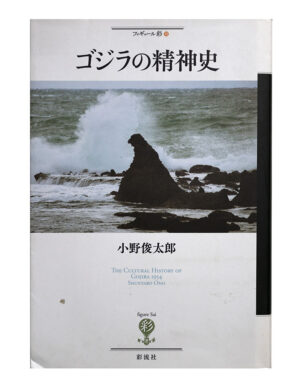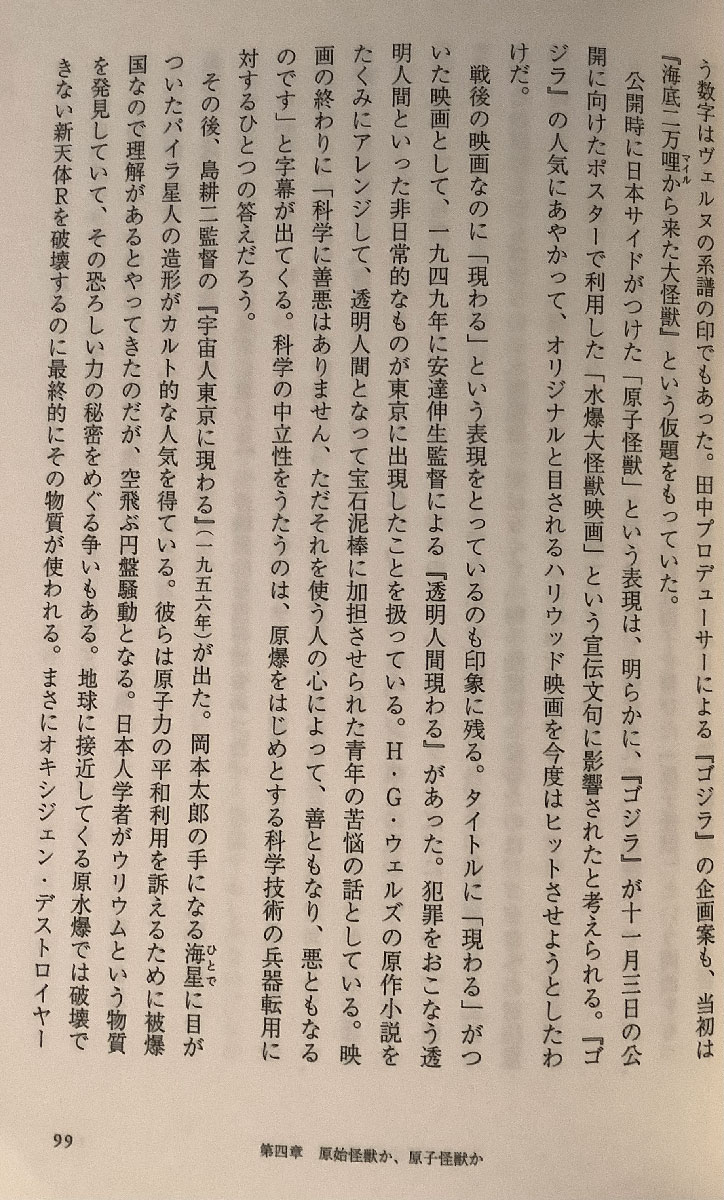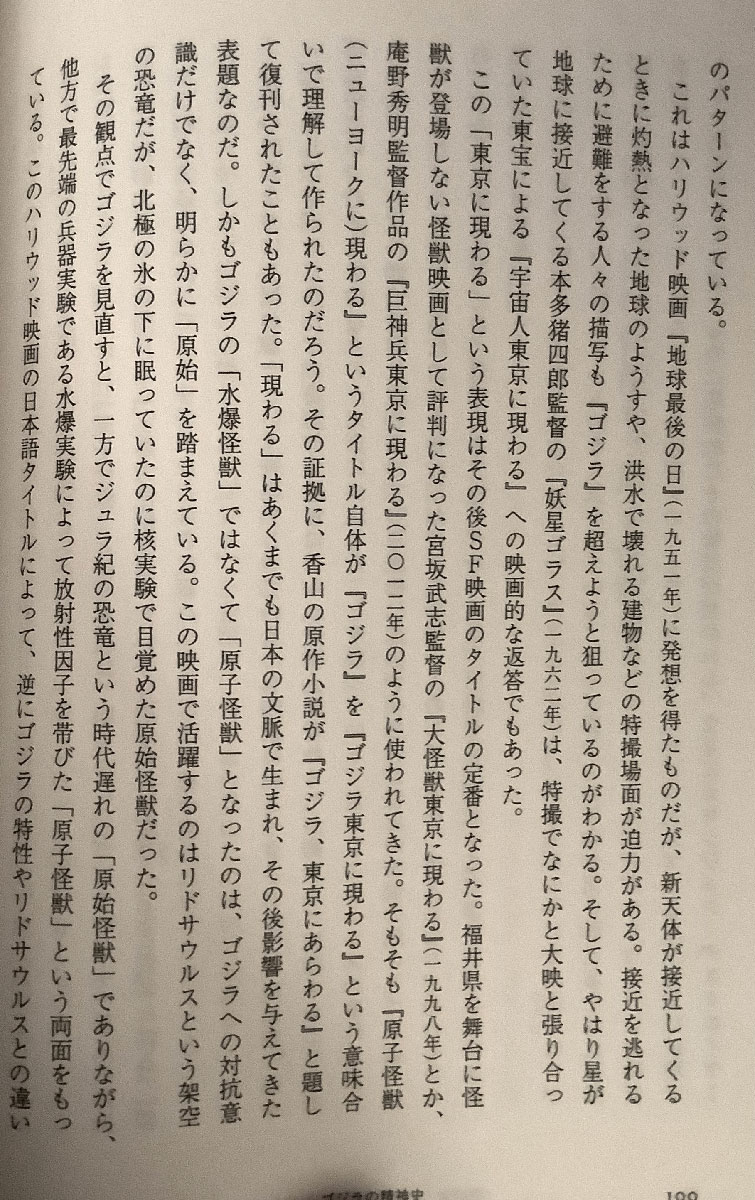4.25.2023
The Cultural History of Godzilla – Pt 39


P 98
第四章 原始怪獣か、原子怪獣か
Chapter 4 Primitive Monsters or Atomic Monsters?
原始怪獣にして原子怪獣
A primitive monster and an atomic monster
「ゴジラ」に多大なインスピレーションを与えたとされる『原子怪獣現わる』は、一九五三年の六月十一日に全米公開された。日本での公開は翌五四年の十二月二十二日で、そこには一年半のブランクがあった。東宝の制作サイドが映画の内容を知るだけの時間的余裕はあったし、だからこそ異なる要素を盛りこむこともできた。
“The Beast from 20,000 Fathoms,” which is said to have been a great inspiration for “Godzilla,” was released in the United States on June 11, 1953. The film was released in Japan on December 22nd, 1954, and there was a gap of one and a half years. Toho’s production side had enough time to know what the movie was about, and that’s why they were able to include different elements.
恐竜が水爆実験で目覚めて海を渡ってたどり着いた大都会を脅かすが人間によって倒される、という中心のストーリーだけを聞くと、二つは同じ作品のように感じられるかもしれないが、当然ながら大きな違いがある。後続の立場となる『ゴジラ』を意図的に異なる作品にしたせいでもあるし、生命観や原因となる水爆実験の扱いも含めた日米の立脚点がずいぶんと異なるのだ。
If you only listen to the central story of a dinosaur waking up from a hydrogen bomb test and threatening a big city that crosses the sea and is defeated by humans, you might feel that the two are the same work. There is a difference. This is partly because Godzilla was intentionally different from the one that followed it, and partly because the standpoints of Japan and the United States, including the outlook on life and the treatment of the hydrogen bomb test that was the cause, are quite different.
日本公開時に『原子怪獣現わる』という邦題となったが、原題は『二万尋から来た獣』だった。尋は約一・八メートルだから、三万六千メートルの深さとなる。現在まで知られているいちばんの深海はマリアナ海溝の一万一千メートル弱なので、地殻のなかに達するほどの到底ありえない深さである。だからこそ太古の地層から蘇るというイメージにふさわしい。第二章で触れたように、「二万」という数字はヴェルヌの系譜の印でもあった。田中プロデューサーによる『ゴジラ』の企画案も、当初は マイル 『海底二万哩から来た大怪獣』という仮題をもっていた。
At the time of its release in Japan, the Japanese title was “Atomic Monster Appears”, but the original title was “The Beast Who Came From Twenty Thousand.” The depth is about 1.8 meters, so the depth is 36,000 meters. The deepest sea known to date is the Mariana Trench, which is less than 11,000 meters deep, which is an impossible depth to reach the earth’s crust. That is why it is suitable for the image of reviving from ancient strata. As mentioned in Chapter 2, the number “20,000” was also a mark of Verne’s genealogy. Producer Tanaka’s “Godzilla” plan originally had the working title of his Mile “The Great Monster Came from 20,000 Miles Under the Sea.”

P 99
公開時に日本サイドがつけた「原子怪獣」という表現は、明らかに、『ゴジラ』が十一月三日の公開に向けたポスターで利用した「水爆大怪獣映画」という宣伝文句に影響されたと考えられる。『ゴジラ』の人気にあやかって、オリジナルと目されるハリウッド映画を今度はヒットさせようとしたわけだ。
The expression “atomic monster” used by the Japanese side at the time of its release was apparently influenced by the advertising phrase “hydrogen bomb giant monster movie” used in the poster for the November 3 release of “Godzilla.” Taking advantage of the popularity of “Godzilla,” he tried to make a Hollywood movie, which is regarded as the original, a hit.
戦後の映画なのに「現わる」という表現をとっているのも印象に残る。タイトルに「現わる」がつ いた映画として、一九四九年に安達伸生監督による『透明人間現わる』があった。犯罪をおこなう透 明人間といった非日常的なものが東京に出現したことを扱っている。H・G・ウェルズの原作小説を たくみにアレンジして、透明人間となって宝石泥棒に加担させられた青年の苦悩の話としている。映 画の終わりに「科学に善悪はありません、ただそれを使う人の心によって、善ともなり、悪ともなる のです」と字幕が出てくる。科学の中立性をうたうのは、原爆をはじめとする科学技術の兵器転用に 対するひとつの答えだろう。
Even though it is a post-war film, the use of the expression “appear” also left an impression on me. The 1949 director Nobuo Adachi’s “Invisible Man Appears” was a film in which he appeared with the word “appear” in the title. It deals with the emergence of extraordinary things in Tokyo, such as invisible men who commit crimes. Based on the original novel by H.G. Wells, he arranged it in his own way to tell the story of the anguish of a young man who becomes invisible and is complicit in a jewel thief. At the end of the film, a caption appears, saying, “There is no good or bad in science, but he can be good or bad depending on the mind of the person who uses it.” Advocating the neutrality of science is one answer to the diversion of science and technology, including the atomic bomb, into weapons.
その後、島耕二監督の『宇宙人東京に現わる』(一九五六年)が出た。岡本太郎の手になる海星に目がひとでついたパイラ星人の造形がカルト的な人気を得ている。彼らは原子力の平和利用を訴えるために被爆 国なので理解があるとやってきたのだが、空飛ぶ円盤騒動となる。日本人学者がウリウムという物質 を発見していて、その恐ろしい力の秘密をめぐる争いもある。 地球に接近してくる原水爆では破壊で きない新天体Rを破壊するのに最終的にその物質が使われる。まさにオキシジェン・デストロイヤーのパターンになっている。
After that, Koji Shima’s “Warning from Space” (1956) came out. Taro Okamoto’s model of Alien Pairans with his eyes on the sea star has gained cult popularity. They came here with understanding because they are a country that has suffered atomic bombings in order to advocate the peaceful use of nuclear energy. Japanese scholars have discovered a substance called urium, and there is a dispute over the secret of its terrifying power. The material is eventually used to destroy the new celestial body R, which cannot be destroyed by an atomic bomb approaching Earth. Exactly the pattern of the Oxygen Destroyer.

P 100-1
これはハリウッド映画『地球最後の日』(一九五一年)に発想を得たものだが、新天体が接近してくるときに灼熱となった地球のようすや、洪水で壊れる建物などの特撮場面が迫力がある。接近を逃れるために避難をする人々の描写も『ゴジラ』を超えようと狙っているのがわかる。そして、やはり星が地球に接近してくる本多猪四郎監督の『妖星ゴラス』(一九六二年)は、特撮でなにかと大映と張り合っていた東宝による『宇宙人東京に現わる』への映画的な返答でもあった。
This was inspired by the Hollywood movie “When Worlds Collide” (1951), but special effects such as the scorching earth as a new celestial body approaches and buildings destroyed by floods. The scene is powerful. It can be seen that the depiction of people who evacuate to avoid approaching is also aiming to surpass “Godzilla.” And then, directed by Ishiro Honda’s “Gorath” (1962), in which the stars are approaching the earth, was also a cinematic response to Toho’s “The Alien Appears in Tokyo”, which was competing with Daiei in special effects.
この「東京に現わる」という表現はその後SF映画のタイトルの定番となった。福井県を舞台に怪獣が登場しない怪獣映画として評判になった宮坂武志監督の『大怪獣東京に現わる』(一九九八年)とか、庵野秀明監督作品の『巨神兵東京に現わる』(二〇一二年)のように使われてきた。そもそも『原子怪獣(ニューヨークに)現わる』というタイトル自体が『ゴジラ』を「ゴジラ東京に現わる」という意味合いで理解して作られたのだろう。その証拠に、香山の原作小説が『ゴジラ、東京にあらわる』と題して復刊されたこともあった。「現わる」はあくまでも日本の文脈で生まれ、その後影響を与えてきた表題なのだ。しかもゴジラの「水爆怪獣」ではなくて「原子怪獣」となったのは、ゴジラへの対抗意識だけでなく、明らかに「原始」を踏まえている。この映画で活躍するのはリドサウルスという架空の恐竜だが、北極の氷の下に眠っていたのに核実験で目覚めた原始怪獣だった。
The expression “appearing in Tokyo” later became a staple of the titles of science fiction films. It has been used in films such as Takeshi Miyasaka’s “Giant God Warrior Appears in Tokyo” (2012), which is set in Fukui Prefecture and where no monsters appear, and Hideaki Anno’s “The Great Monster Appears in Tokyo” (1998). In the first place, the title “Atomic Monster (New York) Appears” [The Beast from 20,000 Fathoms] was probably created by understanding “Godzilla” as “Godzilla Appears in Tokyo.” As evidence of this, Kayama’s original novel was republished under the title “Godzilla Appears in Tokyo.” “Appear” is a title that was born in the context of Japan and has had an impact since then. Moreover, the fact that it became an “atomic monster” instead of Godzilla’s “hydrogen bomb monster” is not only a sense of opposition to Godzilla, but also clearly based on the “original.” The fictional dinosaur Ridosaurus plays an active role in this movie.
その観点でゴジラを見直すと、一方でジュラ紀の恐竜という時代遅れの「原始怪獣」でありながら、他方で最先端の兵器実験である水爆実験によって放射性因子を帯びた「原子怪獣」という両面をもっている。このハリウッド映画の日本語タイトルによって、逆にゴジラの特性やリドサウルスとの違いが明らかになる。この章では、『原子怪獣現わる』との比較とともに、原始怪獣であり原子怪獣であるゴジラの面を扱っていく。
Looking at Godzilla from that perspective, while it is an outdated “primitive monster”, a dinosaur from the Jurassic period, on the other hand, it has two sides: an “atomic monster” that has been given a radioactive factor by hydrogen bomb experiments, which are the most advanced weapon experiments. The Japanese title of this Hollywood movie, on the other hand, reveals the characteristics of Godzilla and the differences from Rydosaurus. In this chapter, we will deal with the aspect of Godzilla, a primitive monster and an atomic monster, along with a comparison with “Atomic Monster Appears” [The Beast from 20,000 Fathoms].